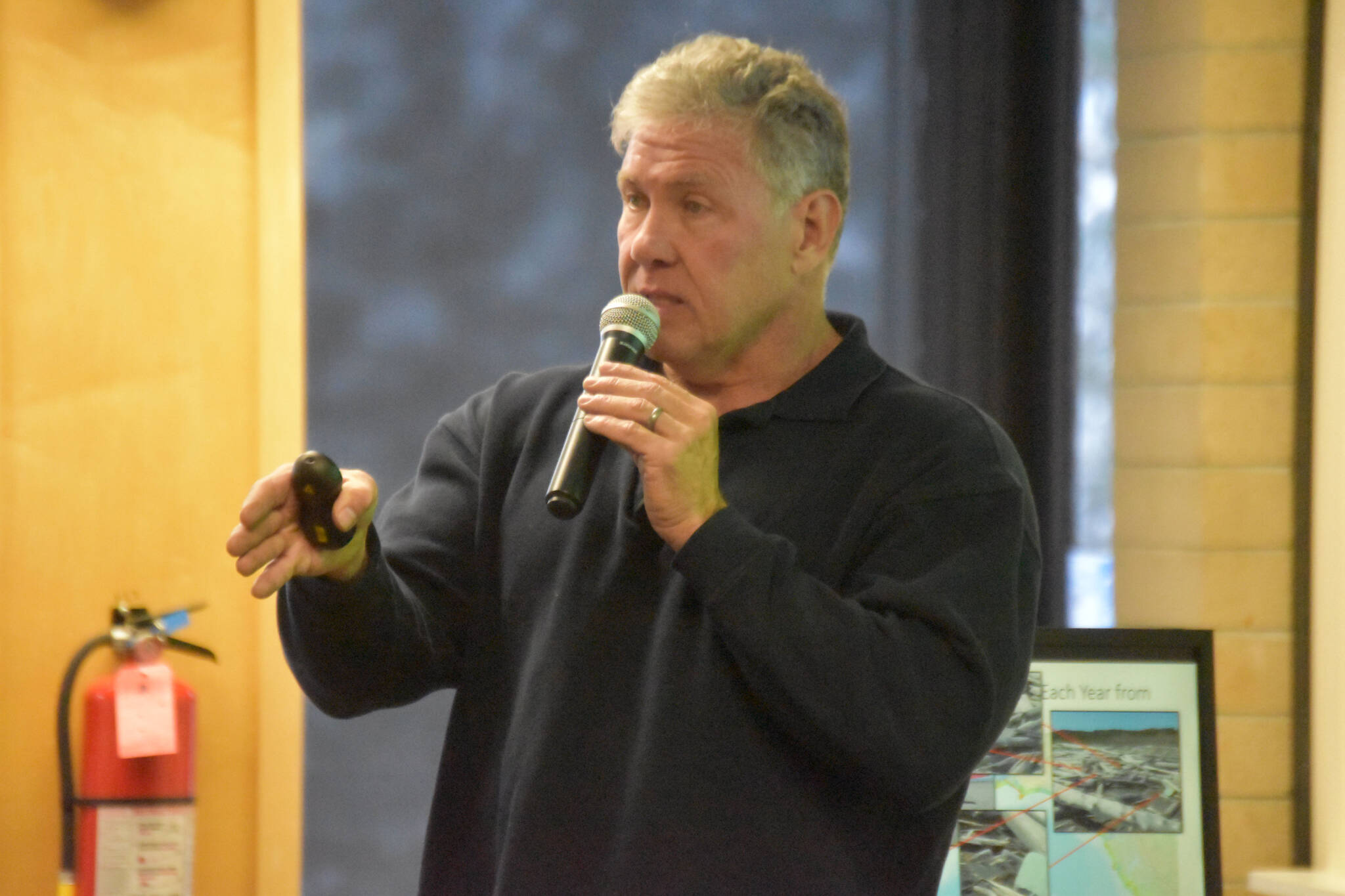Entrepreneur Patrick Simpson, of Alaska Plastic Recovery, has worked for much of the year with local advocacy groups like Cook Inletkeeper, Regroup, and Sustainable Seward to collect plastic for transformation into lumber as part of a recycling program funded by a grant from the Environmental Protection Agency. On Thursday, Simpson put samples of the finished project — a thick green chunk of synthetic lumber — in the hands of borough residents at a Kenai Peninsula College Showcase.
This week’s KPC Showcase, held in partnership with ReGroup and Cook Inletkeeper, was a celebration of the 50th anniversary of the passing of the Clean Water Act, headlined by a showing of the 2016 documentary “A Plastic Ocean.” Ahead of the showing, Simpson gave a presentation about the recycled plastic lumber project, and fielded questions from attendees for nearly 45 minutes.
He covered the concept for the project, the process for creating the lumber, its uses and a look ahead at future plans.
Simpson, who was born in Cordova, described himself as a “serial entrepreneur.”
“What I do is I look for opportunities,” he said. “I think to myself, ‘can I find ways to solve problems, and can the solution make money?’”
Simpson said he spent much of his youth fishing, and when he returned to familiar beaches around Prince William Sound after getting his engineering degree, he found them “covered in plastic.” He said that data from the National Oceanic and Atmospheric Administration in 2015 showed that 375,000 pounds of plastic were removed from beaches just in Alaska, annually.
Further, he said removing plastic from beaches is key for combatting microplastics.
“Big plastic becomes little plastic becomes microplastic, and those microplastics are making their way into our food web,” he said.
He discussed findings from professors at the University of Alaska who necropsied seabirds; they found plastic in their bellies, bloodstreams and muscle tissues.
Simpson had found a problem. But he said the solution wasn’t as simple as just collecting the plastic.
“I started thinking about where there were gaps. One of them is collection, I think that’s kind of obvious,” he said. “But then once we’ve collected it, what do we do with it?”
He said if something could be done — actively — with the plastic, it could be recontextualized as a resource, “less as trash.” Moving plastic from the beach to a landfill is “just moving the problem from one spot to another.”
So Simpson proposed the recycled plastic lumber program to the Small Business Innovation Research program, through which he secured his first funding from the EPA in March of 2021. Since then, he has proceeded to the second phase of the SBIR program, giving him the opportunity to perform a two-year pilot study.
Transporting plastic from around Alaska to a processing facility is not feasible, Simpson said.
“I’m taking the processing to the plastic.”
Simpson has built his processing facility inside of a 53-foot trailer, which can be brought to the plastic, located in different communities. Right now, those communities are Seward and Palmer. In addition to “post-consumer” recycling, Simpson said plastics are being collected directly from the Kenai Peninsula Borough in Seward, from cruise ships, and from companies on the North Slope.
ReGroup and Cook Inletkeeper partnered to collect recyclables in the central peninsula. Plastics from types 1, 2, 4 and 5 can be brought either to Cook Inletkeeper’s Community Action Studio or The Goods + Sustainable Grocery to be deposited into big white weatherproof bags called super sacks — they don’t need to be separated by type. The sacks are then transported to Seward.
Avoiding the need to separate plastics is about avoiding frustrating the people “volunteering their time to give us plastic,” Simpson said.
“If you can give me plastic, I just don’t worry about it,” he said. “I can figure it out, sort through it.”
“If I can’t do something with it now, I’ll figure it out later.”
Long term, the goal is to establish more stockpiles around the state, for the processing facility to be brought to, rather than moving the plastic. Simpson said one of his first goals is a location in Kenai.
“We would stockpile the plastics in communities, take our mobile plastic waste recycler to the community, convert that plastic into something useful, leave that thing behind — in this case, recycled plastic lumber — then move the processing to the next city,” Simpson said.
To store the plastics in Kenai, he said he would need a lot of around 10,000 square feet, which he’s actively looking to acquire.
Further plans to collect plastic include encouraging anglers or other local individuals to collect while they’re out boating, then sell it to Simpson for something like 50 cents a pound. This is inspired by a similar project run by NOAA, and Simpson said he had submitted a proposal to implement earlier on Thursday.
“We would use the fishing community and the recreational boating community to collect plastics, bring them into the seafood processors to weigh them and take custody of them,” he said.
After being collected, the plastic has to be transformed.
The processing facility performs a process called extrusion. Plastic is sorted and sent into the top via conveyor belt. The processor takes the plastics, grinds them up, and then runs them through a long heated tube where they are further worked by a billet, melted, then pushed out into a form; for Simpson’s lumber, that form is a two-by-four, or a two-by-six.
After months as a concept, Simpson recently completed the process, making a stack of two-by-fours out of thread protectors from the North Slope — plastic caps put on the ends of pipes to keep them in good condition during transport.
Those caps were green, so the resulting lumber is a deep green. Simpson said the color would generally match the inputted material, though if he put in a mix — like the post-consumer recycling that has been collected, they would probably just come out a muddy gray.
“This was a big milestone for us, because this actually shows we can do it,” Simpson said. “So now what we’re doing is focusing on where we can do this and feasibility and improving the process.”
The recycled plastic two-by-fours, Simpson said, are expected to last around 15 to 20 years. They can then be reconstituted around seven times.
“So I say somewhere between 75 and 100 years of life. In reality, what happens is after you use it you recycle it and it gets mixed in with (newer) plastics,” he said. “You just don’t get the same piece of plastic used over and over again.”
A super sack holds around 70 to 80 pounds of plastic, and the two-by-fours that Simpson is making are around 15 pounds. So each bag makes around five pieces of lumber. The plastic lumber is denser than wood, but still lighter than water — it’ll float.
To break even, Simpson said he would need around 50,000 pounds of plastic to convert. In Palmer, he has 250,000 pounds, in Seward he has around 45,000 pounds.
“It pretty quickly accumulates,” he said.
After making the lumber, Simpson said the plan is to sell it all locally.
“I don’t want to make a product and then move it. I want to make a product and leave it and sell it locally,” he said.
The target price will be 2 dollars a pound, so $30 for a two-by-four.
Simpson has already established a customer.
American Fast Freight has purchased some of the lumber for dunnage — the wood used to hold freight in place during shipping. Simpson said their general manager complained of using more than 100,000 pounds of wood a year for dunnage. They purchased 20 pieces of lumber from Simpson to test if it lasts longer than the wood they’ve been using.
The capabilities of the lumber was a common thread in questioning for Simpson at the showcase. For the most part, the entrepreneur conceded that they just don’t know yet. He said that he was preparing to take some of the lumber to Alaska Rubber to test things like strength and other metrics, but he also said he didn’t yet have conclusive answers on whether it takes more or less energy to produce the recycled lumber than traditional lumber, what the carbon footprint is, or if arctic environments will affect the life of the product.
The lumber doesn’t have the rigidity for building homes or structures, but would be good for various outdoor uses, like decks, fences or park tables, according to Simpson.
More information about Cook Inletkeeper and ReGroup can be found at inletkeeper.org or ReGroup on Facebook. Plastics of types 1, 2, 4 and 5 can be brought to either recycling location — the Community Action Studio or The Goods — during business hours, and Simpson said Cook Inletkeeper is actively looking for help getting the plastic to Seward or Palmer.
Reach Jake Dye at jacob.dye@peninsulaclarion.com.


